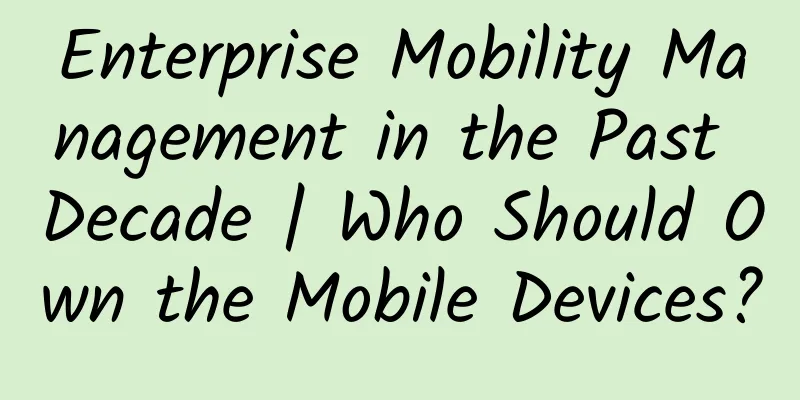Enterprise Mobility Management in the Past Decade | Who Should Own the Mobile Devices?

|
This article is reprinted from the WeChat public account "Computer World", written by Ryan Faas. Please contact the Computer World public account to reprint this article. Apple launched its iOS device management platform in 2010, which put third-party vendors at the center of the EMM industry. A lot has changed in the years since then, including the BYOD boom, new application development and deployment models, the Android Enterprise program led by Google, the failure of Microsoft's mobile device platform, and the COVID-19 pandemic, which has completely changed the way people work. As we gradually return to our normal work lives, now is a good time to take stock - how enterprise mobility management can support employees across industries, how IT departments can manage mobile work, how companies can use mobile platforms to change the way we work, and how mobile can change the way we think about work. In this article, we will share the lessons IT departments have learned along the way. Enterprise Mobility Management is More Than Just Managing Mobile DevicesThe EMM industry, along with both new and existing companies in the industry, experienced explosive growth and subsequent rapid consolidation between 2010 and 2012. As mobile devices became more and more relevant to our work and lives, EMM went from being an add-on technology to one primarily developed by enterprise computing vendors and bundled with other enterprise management services. At the same time, the functionality of EMM products has also been enhanced, starting with simple MDM (mobile device management), and later gradually adding MAM (mobile application management), MCM (mobile content management), network and service management, advanced security features, and the ability to manage additional devices such as PCs and IoT devices. Today, most EMM vendors call their products UEM (unified endpoint management) platforms. Device ownership is far less important than initially thoughtFive to ten years ago, the industry was still struggling with whether users or companies needed a smartphone or other mobile device for every user. At that time, there was a lot of debate about the effectiveness of BYOD (bring your own device, that is, the user owns the device), COPE (company owned, personally enabled) and COBO (company owned, business only, that is, the device is locked and used only for work). As the enterprise mobility space has evolved, this debate has largely disappeared. Many companies have embraced BYOD, providing employees with allowances for using their own technology. Others have embraced COPE. Ultimately, the two approaches aren't that far apart -- both blend personal and work activities on the same device, and what matters more is how the device is managed, not who owns it. Privacy is a key IT issue regardless of who owns the deviceIn the age of mobile work, gaining employee trust has become a challenge for IT departments. Regardless of who owns the device, employees expect privacy and require that personal information (from family photos, health indicators, location data to the games they play) is safe and cannot be viewed or deleted by IT staff. The good news is that all EMM platforms today can implement this privacy protection. However, having this capability alone is not enough, it must be combined with effective policies. IT departments must communicate these privacy policies to users and build trust through interaction with users. Author: Ryan Faas is a staff writer for Computerworld and a technology journalist and author who has been writing about Apple, business and enterprise IT topics, and the mobile industry for more than a decade. Original URL: https://www.computerworld.com/article/3627288/from-mdm-to-uem-in-a-decade-what-we-ve-learned-about-enterprise-mobile-management.html |
Recommend
23 tricks to grab user fans, how many of them have you fallen into?
"How can I get others to pay attention to my...
Products also need to understand operations丨Read "Operations from Scratch" in 3 minutes!
Chapter 1: Some truths about operations 1. Operat...
Some thoughts on Android APP performance optimization
When it comes to Android phones, most people have...
Event operation execution and design!
When asked: What is the purpose of holding activi...
B-side new media operation skills!
"Video" and "community" are u...
Easy learning: the role of IMP pointer in Runtime
You may have seen many friends introduce the conc...
Commonly used words by anchors in live e-commerce live broadcast rooms
According to the latest data this year, the numbe...
Consumption of 10,000, but conversion rate is less than 0.008! How to analyze and optimize accounts?
Today, I would like to share with you a case stud...
Community fission: 5 steps to teach you how to operate a good community
The Internet has experienced a period of rapid de...
A Guide to KOL Advertising on TikTok
What is Douyin KOL? Users who frequently post vid...
How to build a product operation and promotion system for two-dimensional products?
The analysis in this article is mainly to underst...
Overview of advertising in February, inventory of top advertisers for App and brand promotion
According to the mobile advertising intelligence ...
What are the advantages and disadvantages of second-hand houses in Lanzhou, what are the precautions and renovation techniques for second-hand houses in Lanzhou?
Many people want to buy second-hand houses, but w...
5 major scenes and 11 camera techniques for short video shooting
Why do short videos shot by others get millions o...
How to build a core fan group for your live broadcast room?
If a live broadcast room wants to be popular as s...









